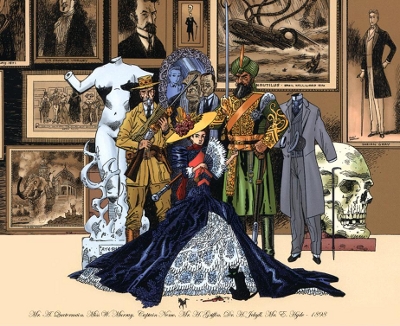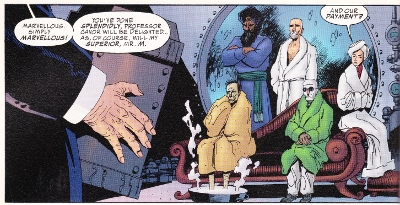|
The League of Extraordinary Gentlemen Volume One

'London.
1898. The Victorian Era draws to a close and the twentieth century
approaches. It is a time of great change and an age of stagnation, a
period of chaste order and ignoble chaos. It is an era in need of
champions.'
The League of Extraordinary
Gentlemen is a graphic novel written by Alan Moore and illustrated by
Kevin O'Neill. It was first published as a comic series in 1999. I've
reviewed some of the later parts of this series (the ones with the most
overt Bond references) for the site so I thought I might as well start
on the others, beginning of course with this first ever volume.
Set in 1898, The League of
Extraordinary Gentlemen can best be described as a Victorian era
Steampunk version of The Justice League with the big twist being that
in this alternate universe fictional characters from the world of
literature are real and all co-exist together. So when the British
Empire is threatened by mysterious forces the government (in some cases
forcibly) recruits various 'extraordinary' and strange people to work
together as a team of champions for them. These are Allan Quatermain
(from King Solomon's Mines), Mina Murray/Harker (from Dracula), Hawley
Griffin (from The Invisible Man), Dr Henry Jekyll (from The Strange
Case of Dr Jekyll and Mr Hyde), and Captain Nemo (from Twenty Thousand
Leagues Under the Sea).
Pressed into service by the
government, this unlikely and eccentric maladjusted superhero team is
soon up to its neck in intrigue and danger as the true nature of their
mission slowly becomes evident with twists, revelations and some big
name villains...
It's a shame that some people
may only know of The League of Extraordinary Gentlemen from the film
adaptation that was apparently Sean Connery's final bow before
retirement. That picture bungled Alan Moore's original concept and
diluted it into a bland action film. It stripped away all the black
humour, the darkness of the characters, the offbeat weirdness and
risque humour. The original is much darker, complex and far more
intelligent. It's completely different.
This
is apparent right at the beginning of the book. Mina Murray meets tubby
spymaster Campion Bond at the White Cliffs of Dover.
Campion Bond (the name 'Bond' here is one of many in-jokes and
references by Moore to famous fictional characters) is recruiting his
"menagerie" in order to save the Empire. He alludes to Murray's
infamous past which has her now far beyond the social pale. Murray is
then sent to Cairo to find Allan Quatermain where she is nearly raped
and finds Quatermain to be an opium addled shadow of his former self.
They are rescued by Captain Nemo
(in his famous submarine Nautilus) - who we quickly learn doesn't have
much time for the British and considers the sea to be his nation. He's
a genuine Indian prince, not James Mason. You quickly find yourself
immersed in the strange and wonderful world of The League of
Extraordinary Gentlemen with its many references and jokes and
fantastic artwork.
There is a lot of stuff in the
book that they couldn't do in a film (without a higher certificate and
an astronomical budget at least). I liked the way that they have to
recruit the rest of the League - this all done in a really clever and
absorbing fashion. Murray and Quatermein go to Paris where, with the
help of Auguste Dupin, they must track down Edward Hyde. Hyde is an
Incredible Hulk style monster with a funny and frequently foul-mouthed
turn of phrase ("A cure? You'll cure me like a wart on Jekyll's arse?")
and turned into a vivid and memorable character in this and indeed the
later second volume by Alan Moore.

Meanwhile, The Invisible Man is
hiding out in a girls school where several of the pupils have been
mysteriously impregnated by "visitations" from Holy Spirits. You can
see why Hollywood had to make big changes when they adapted this book.
The League go undercover here to flush him out in an amusing section.
Another great bit occurs in London's Chinese district where one of the
major villains is revealed. There are some really striking drawings of
Dr Jekyll in shadow in this section that I like a lot.
Jekyll is increasingly nervous
and erratic and becoming more and more under the control of Hyde. Moore
also makes clever use of Hawley Griffin and his unique abilities and
gives Griffin and Hyde especially a sardonic and dark sense of humour.
There is a great moment where Griffin sits in undetected on a
discussion by one of the famous villains (who I won't reveal) and
chuckles when they leave and he is alone.
Griffin is presented as the most
untrustworthy member and it makes his character and interactions with
the League more interesting. All the characters are interesting though
and you enjoy all the disputes and conversations between them. In this
world they are deeply flawed characters who must decide what to do with
this unexpected duty.
I like the treatment of
Quatermain too. He's old now and has suffered from drug addiction but
the lure of one last adventure gradually brings out some of the
qualities that made him such a legendary figure. There is a nice bit
with him and Nemo where they reflect that it's hard to resist a new
adventure when you've been doing it for so long. Mina Murray even
mentions that she read about Quatermain and his exploits when she was a
girl. Murray here is much more interesting than in the film (where she
was a super-powered Australian supermodel with a hat on if I recall).
She's the true leader of the League here - although her past is left at
slightly ambiguous.
Nemo is a more dangerous and
embittered character than in the film version but retains a strong
sense of dignity. Moore and his artist make fantastic use of Nemo's
submarine. The incredible technology and gadgets and the illustrations
depicting the characters onboard are very well done and atmospheric.
The Indian art and designs they lace the submarine with give it a real
sense of character.
Alan Moore said he left out
Sherlock Holmes and Dracula in The League of Extraordinary Gentlemen
because he felt such big characters might overshadow the book. It was
probably a wise decision but the Great Detective - drawn a bit like
Basil Rathbone - does make a guest appearance in a flashback scene
which is quite wonderful and includes a few Alan Moore twists on a very
famous fictional encounter at a certain waterfall.
It all builds to a frantic
finish with some great battle illustrations and even sets up the next
chapter of the League. There are subtle hints at this through the book
with stories of strange explosions on the surface of Mars. These little
references are great fun. I liked having the head of British
Intelligence called M and of course the inclusion of Cavourite (HG
Wells fans should enjoy all the references in the first two volumes) -
an anti-gravity element that is planned for a mission to the moon.
Overall, The League of
Extraordinary Gentlemen is a fascinating premise done full justice by
this graphic novel. It's full of literary references, twists and turns
and exciting developments. The Steampunk world it takes place in - an
alternate reality Victorian backdrop - is great fun and fleshed out
with much imagination.
- Jake
c 2014
Alternative 007
|

|


